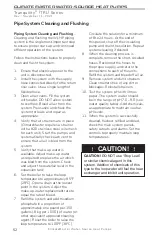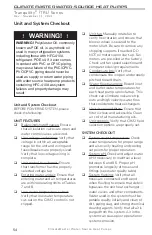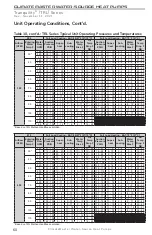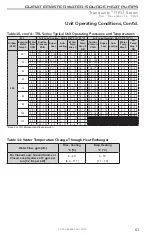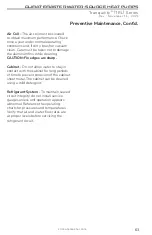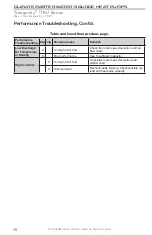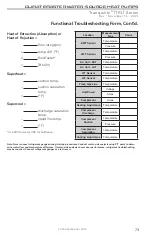
CLIMATEMASTER WATER-SOURCE HEAT PUMPS
Tranquility
®
(TRL) Series
R e v. : N o v e m b e r 1 1 , 2 0 2 1
C l i m a t e M a s t e r Wa t e r-S o u rc e H e a t P u m p s
62
Preventive Maintenance
Brazed Plate Heat Exchanger
Maintenance - TRL should not be
applied to ground water applications.
Brazed Plate Heat Exchanger
Maintenance -
(All other water loop
applications) Generally brazed plate heat
exchanger (BPHX) maintenance is not
needed for closed loop systems. However,
if the piping is known to have high dirt
or debris content, it is best to establish a
periodic maintenance schedule with the
owner so the BPHX water strainer can
be checked regularly. Dirty installations
are typically the result of deterioration of
iron or galvanized piping or components
in the system. Open cooling towers
requiring heavy chemical treatment and
mineral buildup through water use can
also contribute to higher maintenance and
should never be paired with TRL systems
unless an indeterminate heat exchanger
is used in the water loop system. The
unit water strainer should be periodically
cleaned.
Water loop systems with poor
water quality/dirt/debris in the system
will require the strainer be cleaned out
more frequently.
Should periodic coil
cleaning be necessary, use standard coil
cleaning procedures, which are compatible
with both the heat exchanger material and
copper water lines. Generally, the more
water flowing through the unit, the less
chance for scaling. However, flow rates
over 3 gpm per ton (3.9 l/m per kW) can
produce water (or debris) velocities that
can erode the heat exchanger wall and
ultimately produce leaks.
Filters -
Filters must be clean to obtain
maximum performance. Filters should
be inspected every month under normal
operating conditions and be replaced
when necessary. Units should never be
operated without a filter.
Washable, high efficiency, electrostatic
filters, when dirty, can exhibit a very
high pressure drop for the fan motor
and reduce air flow, resulting in poor
performance. It is especially important
to provide consistent washing of these
filters (in the opposite direction of the
normal air flow) once per month using a
high pressure wash similar to those found
at self-serve car washes.
Condensate Drain -
In areas where
airborne bacteria may produce a “slimy”
substance in the drain pan, it may be
necessary to treat the drain pan chemically
with an algaecide approximately every
three months to minimize the problem.
The condensate pan may also need to be
cleaned periodically to ensure indoor air
quality. The condensate drain can pick up
lint and dirt, especially with dirty filters.
Inspect the drain twice a year to avoid
the possibility of plugging and eventual
overflow.
Compressor -
Conduct annual amperage
checks to ensure that amp draw is no
more than 10% greater than indicated on
the serial plate data.
Fan Motors -
All units have lubricated
fan motors. Fan motors should never be
lubricated unless obvious, dry operation is
suspected. Periodic maintenance oiling is
not recommended, as it will result in dirt
accumulating in the excess oil and cause
eventual motor failure. Conduct annual
dry operation check and amperage check
to ensure amp draw is no more than 10%
greater than indicated on serial plate data.





